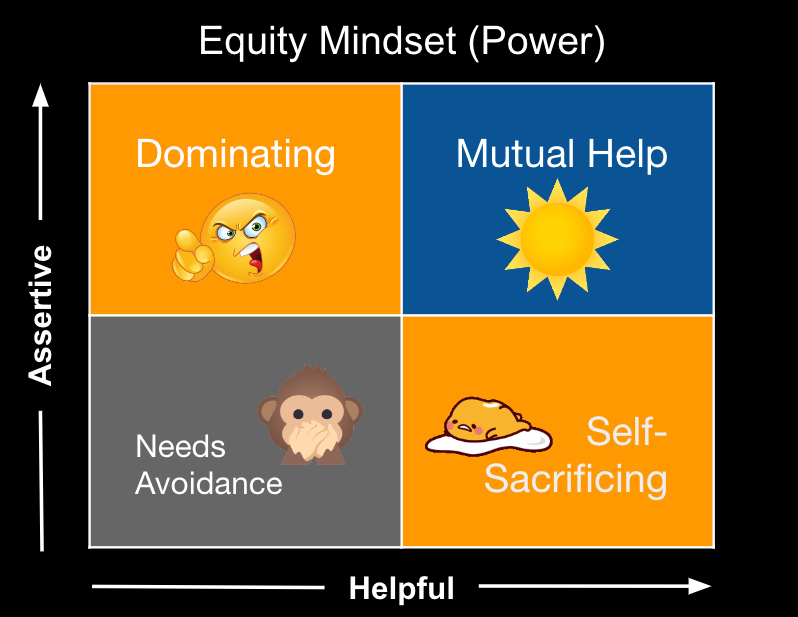Self-Management: become aware of your equity mindset
Understanding assertiveness and how to use it effectively
A part of my executive coaching I work with clients to help them gain perspective on how they show up as leaders and how their fundamental thinking impacts their behaviours. Some are more aware than others about their tendencies in interactions with others and how it impacts their decision making and leadership.
A common topic is around assertiveness, which many leaders associate with getting their teams to do what they want. The opposite of assertiveness seems to be ‘being nice’ (empathetic) or helpful. But is it?
In the beginning of our coaching partnership I usually do a Harrison Assessment with my clients, a survey that identifies their preferences and strengths across 175 attributes. One output is the Paradox Report, that breaks up abilities related to leadership into two traits, that appear contradictory, but are in fact both true and in combination most effective. The paradox related to assertiveness (and effectively power) is shown below as a matrix:
First, some definitions:
Equity Mindset (Power): The tendency to assert your own needs while also responding to others needs (aka win-win).
Assertive: the tendency to put forward personal wants and needs.
Unlike in colloquial use, there is no element of forcefulness or even aggression / bullying in this definition. It is rather about the general comfort and willingness to express what you want.Helpful is self explanatory: the tendency to respond to others’ needs and assist or support others to achieve their goals
The goal: Mutual Help, or win-win ◳
Definition: Preference to pursue solutions that are beneficial to all parties
When your are naturally in this top-right quadrant, you are equally comfortable to say what you want and at the same time interested in helping others. This leads to highest effectiveness, as there are multiple advantages:
Build mutually beneficial relationships
Build trust, clarity and harmony
Encourage others to reach their goals
Fulfil your own and your startup’s needs
Support others to grow their capabilities
Motivate, engage and retain
Neither dominating nor self-sacrificing
Active or dynamic imbalance: Dominating ◰
Definition: this person has a tendency to be highly assertive (i.e. express personal needs freely) without being naturally helpful to others.
This preference has some positive aspects
Good at asking for what you want
Progress towards goals
Others may comply
but also comes at a cost:
May insufficiently respond to others’ needs
Others may feel exploited or resentful
May damage trust and cooperation
Recommendations
What can you do when your preference is ‘Dominating’?
Reframe helpful from unnecessary to beneficial. I have a client who has very high standards and no problem at all to express what he wants. He is very self-driven and expects his team to be the same. As such, he was more biased to drive forward and set direction and pace. Through coaching, he came to the understanding, that if he wants to be successful, he needs to spend some time supporting team members who could not catch-up.
Some more tactical measures to move from Dominating to Mutual Help:
Take time to explore others’ needs
Ask what would be helpful
Review what others want from a deal
Create ways to maximise benefit
Passive imbalance: self sacrificing ◲
Definition: tendency to respond to others needs without sufficiently expressing one’s own.
Some people get more satisfaction from helping others than from driving their own agenda. As the opposite case, this has positive as well as counterproductive implications:
Builds positive relationships
Help others to achieve
Helpfulness can be personally fulfilling
There are two main problems with self-sacrificing leaders:
It usually is not sustainable. Others may unfairly take advantage of the manager. Under stress the person could flip to being self-centered (i.e. someone with self-sacrificing tendency can become dominating if she feels that others have taken advantage of her helpfulness)
It also is not good management: self-sacrificing leaders frequently are agreeable and over-commit, because they can’t say ‘no’. This later creates problems in the organisation. They also create dependencies and hinder the development of team members.
Recommendations
What to do when preference for ‘Self Sacrificing’?
Some people think that expressing their own wishes is selfish and associate assertiveness with bullying. They need to reframe assertive as providing clarity and creating mutual benefit.
One of my clients wanted to become more assertive as he interpreted his own behaviour as being ‘too nice’. Using the paradox model, I could convince him not to become ‘less nice’, but remain as helpful as he naturally was and become more clear and expressive about his own needs. As a result he became much more effective as a leader.
Some practical recommendations to overcome the issues of self-sacrificing management:
Ensure project deadlines are realistic
Clarify priorities
Help in a manner to build capability
Don’t overextend and create stress
Facilitate others to resolve problems
Application
Do you recognise what your preferred behaviour is? Are there any challenges that sound familiar? Most likely you recognise where you stand.
Ask yourself
How can you reframe your current believes about assertiveness or helpfulness to a balanced combination of both?
Which of the recommended actions resonate with you? Are you ready to commit to implement them?
What strengths and abilities do you have, that can help you move to the Mutual Help quadrant?
Enduring and positive relationships are a result of meeting mutual needs.
I hope you find this article useful. If you have some time, please drop me an email or leave a comment.
If you are curious to better understand your behavioural preferences and how they impact your leadership please do connect with me directly.



